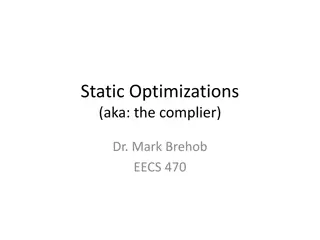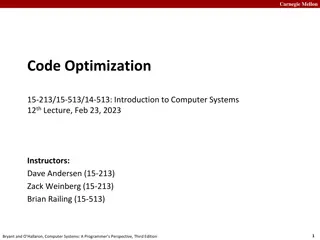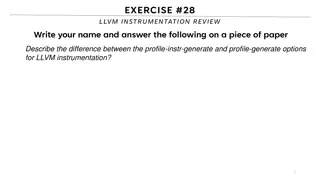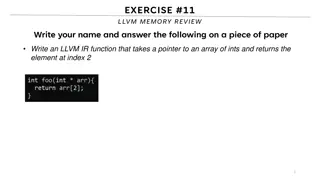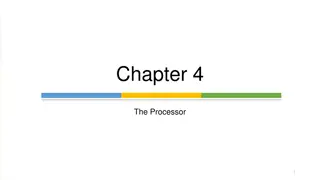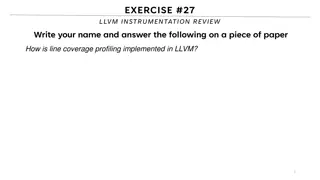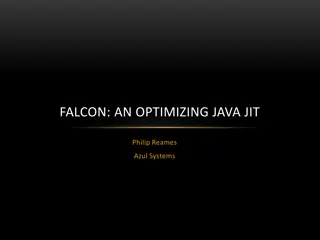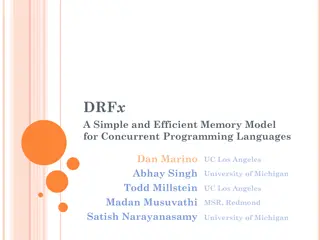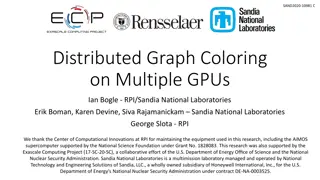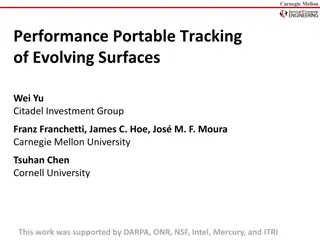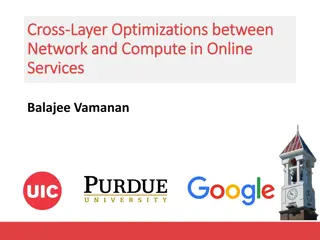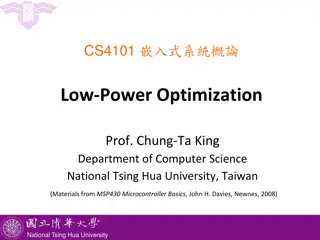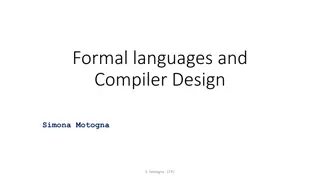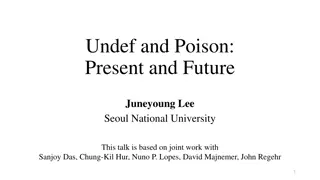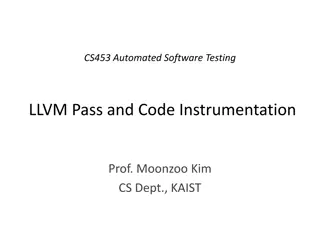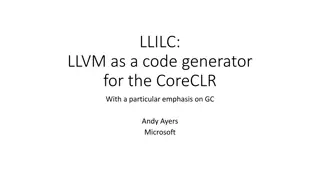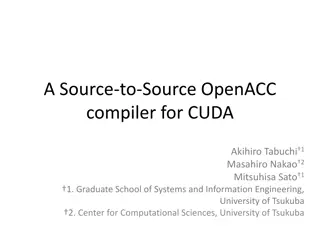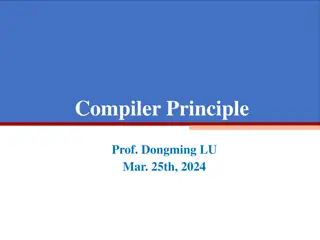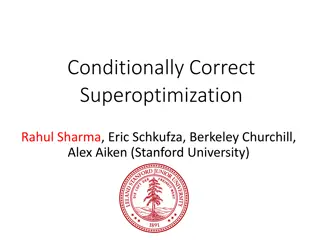Understanding Compiler Optimizations in LLVM: Challenges and Solutions
Compiler optimizations in LLVM, such as loop vectorization, are crucial for enhancing program performance. However, understanding and addressing optimization challenges, like backward dependencies, can be complex. This article explores how LLVM values map to corresponding source-level expressions and highlights key aspects of dealing with optimization issues in Clang.
Download Presentation

Please find below an Image/Link to download the presentation.
The content on the website is provided AS IS for your information and personal use only. It may not be sold, licensed, or shared on other websites without obtaining consent from the author. Download presentation by click this link. If you encounter any issues during the download, it is possible that the publisher has removed the file from their server.
E N D
Presentation Transcript
Mapping LLVM Values to corresponding source level expression
But Why? The Challenge of Understanding Compiler Optimizations:
But Why? The Challenge of Understanding Compiler Optimizations: Compilers like Clang perform complex optimizations, such as loop vectorization, to enhance program performance.
But Why? The Challenge of Understanding Compiler Optimizations: Compilers like Clang perform complex optimizations, such as loop vectorization, to enhance program performance. Understanding why and how these optimizations occur is not always straightforward, even for experienced developers.
Consider an example : void test_dependency(int n, int *A) { for (int i = 1; i <= n - 3; i += 3) { A[i] = A[i-1]; A[i+1] = A[i+3]; } } Loop does not get vectorized since it contains a backward dependency between A[i] and A[i+3].
Remark produced by clang with -03 and -Rpass-analysis=loop-vectorize remark: loop not vectorized: unsafe dependent memory operations in loop. Use #pragma loop distribute(enable) to allow loop distribution to attempt to isolate the offending operations into a separate loop
A bit unclear right? How About this? remark: loop not vectorized: unsafe dependent memory operations in loop. Use #pragma loop distribute(enable) to allow loop distribution to attempt to isolate the offending operations into a separate loop, Dependence Source : &A[i] and Dependence Destination : &A[(i + 3)]
Mapping LLVM Values to source level expression surely enhanced remark includes the exact source and destination of the dependency within the array, pinpointing the lines of code causing the vectorization issue.
Impact of Enhanced Remarks Clarity: Developers can quickly identify the exact dependency that prevents vectorization.
Impact of Enhanced Remarks Clarity: Developers can quickly identify the exact dependency that prevents vectorization. Efficiency: Saves time and improves efficiency by reducing the need for deep debugging to understand optimization reports.
Lets Look at our approach to solve this problem: Approach: Utilize debug information to recreate variable and function names lost during optimization, making remarks more precise and actionable.
Lets Look at our approach to solve this problem: Approach: Utilize debug information to recreate variable and function names lost during optimization, making remarks more precise and actionable. Hmm how to utilize that?
Lets Look at our approach to solve this problem: Approach: Utilize debug information to recreate variable and function names lost during optimization, making remarks more precise and actionable. Hmm how to utilize that? LLVM implementation uses a small set of intrinsics function to define a mapping between LLVM program objects and the source-level objects.
These intrinsic functions (name prefixed with llvm.dbg) helps to track source local variables through optimization and code generation.
These intrinsic functions (name prefixed with llvm.dbg) helps to track source local variables through optimization and code generation. For us two important intrinsic functions are llvm.dbg.declare and llvm.dbg.value .
We cant miss an example to understand! %i.addr = alloca i32, align 4 call void @llvm.dbg.declare(metadata i32* %i.addr, metadata !1, metadata !DIExpression()), !dbg !2 !1 = !DILocalVariable(name: "i", ...) ; int i !2 = !DILocation(...)
We cant miss an example to understand! %i.addr = alloca i32, align 4 call void @llvm.dbg.declare(metadata i32* %i.addr, metadata !1, metadata !DIExpression()), !dbg !2 !1 = !DILocalVariable(name: "i", ...) ; int i !2 = !DILocation(...) When i is allocated (%i.addr = alloca i32, align 4), llvm.dbg.declare is called with %i.addr to link the variable i with its declaration location in the source (!DILocalVariable(name: "i", ...) and !DILocation(...)).
And for llvm.dbg.value: If in the subsequent IR, i is updated (%new_i = add i32 %i, 1), llvm.dbg.value can be used to indicate that i now has a new value (%new_i), linking this updated value to the variable's source-level information.
So, Now we know we have enough information to at least give a try to build the source expression if the code is compiled with debug info onn (compiled using the option g ).
So, Now we know we have enough information to at least give a try to build the source expression if the code is compiled with debug info onn (compiled using the option g ). We used LLVM Intrinsic as a bridge provide detailed insights into the origins of specific IR constructs.
Focus on Memory Access and Vectorization Importance of Memory Access Patterns: Efficient memory access is crucial for performance, especially for applications that can benefit from vectorization. Vectorization allows for multiple data operations to be performed in parallel, significantly speeding up computation.
Focus on Memory Access and Vectorization Importance of Memory Access Patterns: Efficient memory access is crucial for performance, especially for applications that can benefit from vectorization. Vectorization allows for multiple data operations to be performed in parallel, significantly speeding up computation. Project's Contribution: By providing detailed source-level mappings, the project aids in identifying inefficient memory access patterns. This insight allows developers to restructure code, ensuring that memory accesses are aligned and contiguous where possible, thereby enabling more effective vectorization.
Implementation Detail: For us the point of interest is load and store instruction, because we want to analyse the memory access patterns, which is useful for providing the remarks for vectorization.
Implementation Detail: For us the point of interest is load and store instruction, because we want to analyse the memory access patterns, which is useful for providing the remarks for vectorization. long foo(long *lp, long n1, long n2) { return lp[2 * n1 + n2]; } If you compile above using clang -O2 -S -g -emit-llvm test.c
And we want to set this mapping for e.g. %4 --> n1 << 1 %5 --> (n1 << 1) + n2 %6 --> &lp[(n1 << 1) + n2] %7 --> *(&lp[(n1 << 1) + n2]) --> lp[(n1 << 1) + n2]
As you can see from this example: Computing the equivalent source expressions of interest will involve walking LLVM IR and using information provided in debug intrinsics.
As you can see from this example: Computing the equivalent source expressions of interest will involve walking LLVM IR and using information provided in debug intrinsics. Even though our current interest is addresses used in load/store instructions, in order to compute the needed information we will need to compute the same for other LLVM instructions.
As you can see from this example: Computing the equivalent source expressions of interest will involve walking LLVM IR and using information provided in debug intrinsics. Even though our current interest is addresses used in load/store instructions, in order to compute the needed information we will need to compute the same for other LLVM instructions. Optimizations may make it impossible to recover the original source expression. In the case above, for example 2 * n1 is optimized to n1 << 1 and recovering the original expression may not be possible.
Implementation detail cont. Traverse IR: Begin with a traversal of the LLVM Intermediate Representation, focusing on the structure of the function's basic blocks
Implementation detail cont. Traverse IR: Begin with a traversal of the LLVM Intermediate Representation, focusing on the structure of the function's basic blocks Identify Operations: Specifically look for load and store instructions as they are directly involved in memory access and data flow, crucial for understanding variable usage and dependencies.
Implementation detail cont. Traverse IR: Begin with a traversal of the LLVM Intermediate Representation, focusing on the structure of the function's basic blocks Identify Operations: Specifically look for load and store instructions as they are directly involved in memory access and data flow, crucial for understanding variable usage and dependencies. Trace Operands: For each identified operation, trace back its operands. This may involve following chains of instructions to understand the origin of values.
Implementation detail cont. Utilize Metadata: Check if operands or their related instructions are associated with debug metadata. This metadata, generated with the -g option during compilation, includes crucial source-level information like variable names.
Implementation detail cont. Utilize Metadata: Check if operands or their related instructions are associated with debug metadata. This metadata, generated with the -g option during compilation, includes crucial source-level information like variable names. Reconstruct Expressions: Leveraging the traced instructions and metadata, reconstruct the equivalent source-level expression. This involves understanding the semantics of the LLVM IR instructions and how they map to source code constructs.
Current State Not yet upstream to LLVM. PR [Analysis][LV] Map LLVM values to source level expression by phyBrackets Pull Request #66591 llvm/llvm-project GitHub We need more review on the patch and some active work from me and if any of you interested. Struct pose a unique challenge due to their intricate representation with the IR. Accurate source level expression in case of optimization is still a problem. There isn t always a 1:1 mapping between source code and IR: sometimes multiple source code constructions result in the same IR, e.g. *ptr and ptr[0]. Which pattern should be used when there are multiple options?
Reach Out to me in case any of you interested in knowing more about the project and the algorithm. Contact : physhivam@gmail.com Discord : @phybrackets Thank You for Listening!



